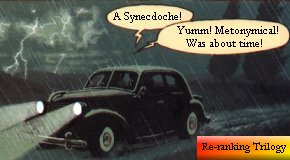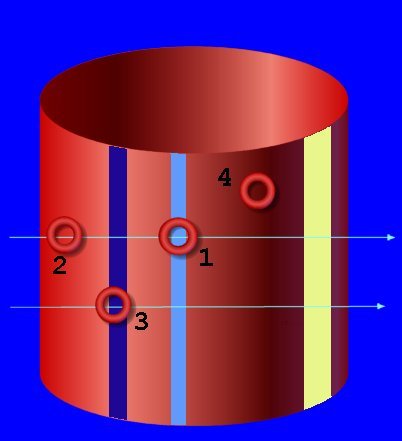Back to where
[you came from]
[fravia's tips]
[evaluation lore]
[main portal]
[Essays]

one:[yoyo1.htm]: The yo-yo technique
three:[epanalep.htm]: The epanaleptical approach
The synecdochical searching method
by fravia+
first published @ searchlores in December 2001
Updated in January 2002
with useful linguistic corrections provided by Anna
[synecdochical searching] [A visual explanation] [Conclusion]
A Synecdoche ("sin-EK-doh-kee") is the rhetorical or metaphorical substitution of a part for the whole, or vice versa. This approach is widely used in searching, because it allows you to get at your signal 'from the bottom', eliminating part of the noise. Synecdoche is a Greek, Latin (and at the same time English) term. You may peruse some linguistic variants of the term @ OED.
The 'Moundarren' field case
Speaking on a messageboard about haiku (maybe the supreme achievement of zen culture)
I advised
a friend to check the books of a French editor: Moundarren.
Shortly afterwards I did myself a search for
Moundarren on the main search engines, and
this
revealed a cluster of sites -mostly French, but not only - dealing with zen, haiku, and more generally with
Chinese and Japanese poetry. It is what I call an 'arrow' or a 'clean cut' for my target.
Let's define as
'clean cut'
any search query that allows you to 'cut' through commercial crap and get
a 'useful' or 'promising'
cluster of sites that provides REALLY some useful knowledge (or further pointers).
No other common denominator would have connected those specific sites, nor was the term Moundarren a term that those sites had ever used purposedly in order to "qualify" themselves (as opposed to 'haiku' or 'French Publications on Zen').
Hence the use of 'Moundarren' as searching term automatically dug out (mined) a cluster of very specialized pages 'from the bottom'.
This kind of 'synecdochical' approach is of course already well known among seekers, but, as far as I am aware, it has never been categorized.
From the example above we can immediately derive some possible pointers, i.e. searching suggestions. More arrows for our search-quiver. I have decided to call 'horizontal' all pointers that exploit the same 'plane' of approach (that in our case was an editor / publisher, but that could of course be anything you can devise for your own queries) and 'vertical' those pointers that move to other 'query planes' while still aiming at the same target signal.
- an horizontal, "regional", longitude:
there must exist at least some other regional equivalent for non french clusters (the best german, uk, usa, italian, spanish specialized editors)
For instance Red+Moon+Press -
another horizontal, "regional", longitude:
there may exist at least some other regional equivalent for clusters in the SAME area (in this case french)
q=%28%22publications+orientales%22+OR+pof%29+AND+haiku (publications orientales de France) -
another horizontal "thematical" longitude:
if we arrive to identify the japanese editor of choice (even without knowing japanese), we can hit a bingo unifying different regional clusters!
Kodansha International haiku -
a vertical, "thematical", latitude:
there must be OTHER 'uncommon' search terms that would deliver similar clusters
Izumi-shikibu
One of the problem here is the definition of 'uncommon'. Clearly many of the sites you dug out through 'Izumi-shikibu' would have emerged from the noise using any other famous haiku poets' name like 'Shiki', 'Santoka' or ' Basho' (or -also- all three together... eheh). It is in this difficult field: determining WHAT is 'uncommon', more than anywhere else, where amateur searchers make most mistakes. A deep knowledge of the subject you are targeting would of course help, and the more you search a specific subject / thread, the more you're likely to dig out pointed arrows to cut your own private tunnel 'under the commercial noise' towards your signal. Yet experienced seekers will also be able to 'improvise' after a 5 minutes broad search on ANY subject. After having read this text all readers may try their own searches for Haiku (without using the pointers I have given) and be amazed at the variety of results. -
a vertical, "syntactical", latitude:
Note the diaeresis in the word haïku here, reflecting the French way of calling Haiku, e.g. with this search: q=ha%EFku we will still remain 'inside the francophonie' (we landed here with the French arrow 'Moundarren' to start with, remember?) and yet change completely the targeted clusters...
Nota bene this %EF code in the query corresponds to the ASCII CODE of ï (it's the hexadecimal value for 239... the more you understand assembly the better you can search the web :-)
You'll find all the very useful ASCII codes at http://www.searchlores.org/ascii.txt.
Using such characters in your queries you will 'cut the noise' quite considerably.
But it is not only a matter of fancy characters.
The 'correct' transliteration of your arrows is also very important.
Unfortunately - given the euroamerican predominance in the development of the web - for many languages this is still often realized through images :-(
Let's make a different example for our 'vertical syntactical approach': let's take the wondrous Basho once again. Let's search for "bah-shoh" (another way to write the name Basho).
This of course re-state, once more the immense importance of names on the web. -
the main vertical, "metonymical", latitude:
Note that all the following arrows can be quickly found on the clusters you started with:
tanka (a poetic form that requires 31 onji, and is divided into 5 lines of 5-7-5-7-7 onji each);
waka (too much noise, throw away this broken arrow, else you'll need something like +waka +31 -indonesia -bali to shoot with, 31 being the syllabes of a waka);
renga (collaborative haiku. This search was on wisenut, I'm using google elsewhere just for the examples, but you should ALWAYS try more than one main search engine, duh);
senryu (colloquial in style, concerned with more mundane topics than haiku. Note that you could have a special syntactical arrow here with senry%FB = senryû, see the previous synecdoche);
haibun (combining Prosa and haiku / senryû);
kigo (the 'season word' there are thousands kigo whose connection to a particular season is relatively arbitrary);
kire-ji OR kireji (a kireji pauses the reader, like punctuation in english);
haiga (illustrations: this leaves our 'poetry environment' and cuts into a new 'pictorial' environment). -
the vertical, "peristasical", latitude:
Now 'the whole for the part': this is the oldest synecdochical trick of the bag, but it works wonders and deserves a specific name. To apply it here, we will use some complete haiku lines as 'bait' in order to fish target clusters!
Have a look:
"a crow perches" "autumn twilight", or even better "karasu-no tomari-keri" which is the japanese for "a crow perches" and will deliver you a wealth of different translations into english (and other languages as well).
Simple name/surname peristasis for Basho:
+"Matsuo Basho", and for Issa (thanks Jeff): "Kobayashi Issa", or also: "Yosa Buson" and, more specialized, "Taniguchi Buson".
Yet this 'peristasical' approach SHOULD NOT be limited to names! Dates or specific characteristics of your targets can be of great help as well:
+Basho +"1644-1694"
Peristasis works always. It is in my opinion most useful for text searching. The quantity of crap sites that speak about Authors but DO NOT HAVE THE COMPLETE TEXT (that you are looking for) can be at once 'undercut' with medium-long text strings.
Let's say you want to find the text of an old song from Donovan... You could of course use the simple string +donovan +"little pebble", but you would probably find better results with the string "Thought is like a little boat upon the sea" which is part of the song you are looking for and that you casually remember.
Similarly: you want to find Tolkien on the web? You shoot a long string arrow! "taking his axe the dwarf now cut several branches.".
Where is the 'Edictus Rothari' on the web?
"omnes liberti, qui a dominis suis langobardis libertatem meruerint" and so on and so on.
(It would be a good idea to press your keyboard's 'f11' key right now :-)
The red cylinder below represents the TOTALITY of accessible web sites that could be of interest to you in the context of your current search, the small rings depict four different specific clusters of interesting sites.
Please remember that inside the cylinder the 'void' is only APPARENT! That's the part of the internet you cannot reach through the main search engines. There are interesting sites there as well (as a matter of fact MUCH more than on the 'accessible' outside), but to grab them you'll have to use more advanced techniques than commercial engines :-)

1 You land first time to an interesting cluster of sites trough your 'clean cut'
2 You have 'synecdochically' moved horizontally, modifying your original clean-cut
3 These sites will be relatively easy to find, they are both on an horizontal and on a vertical synecdoche. Note that the signal width of the vertical synecdoches (e.g. the yellow one on the right side of the image) may vary quite a lot, while horizontal synecdoches' width seems more costant.
4 You'll never find this cluster with your current synecdochical approaches, you'll have to devise a COMPLETELY DIFFERENT cut.
To conclude: In rhetoric a synecdoche may take two colors: genus-species or part-whole. In searching it may appear either as a 'whole' (upper) category, that encompasses your original arrow in a more global concept, or - conversely - as a 'part' (lower) hyperspecialized term, that will allow you to collect more specific clusters. In both cases you may mowe either horizontally, remaining on the same plane of approach, yet changing your 'angle' of attack, or you may move vertically, changing plane and angle of attack, while still aiming at the same target.
The synecdochical searching method is thus not rigid nor precisely quantifiable in all its vertical and horizontal marges, but probably best viewed as a 'continuum' whereby the part-whole or species-genus synecdoche is "simpler"... That is 'apprehensible with less prior knowledge of the quarry'; whereas the genus-species (or class-member) synecdoche is consequently "more complex" since it relies on more knowledge of your target and its 'habitat' on the web. Anyway keep in mind our seekers' motto: "Non refert quam multos sitos, sed quam bonos invenias"
| December 2001: in fieri, I doubt I'll ever finish this lore... in the meantime your search bows have acquired some extra strings, and you may even enjoy some Haiku... |
The web site you seek cannot be located, but countless more exist |

Back to the essays